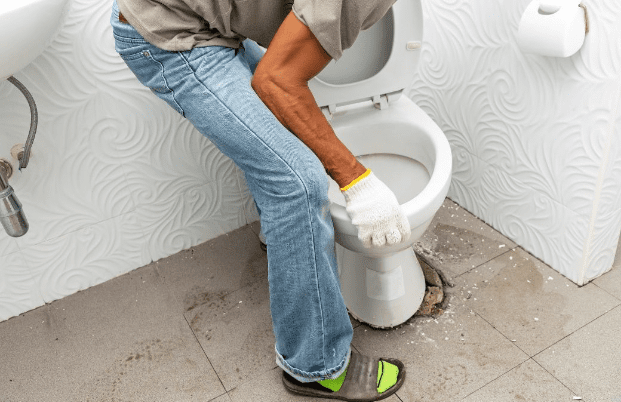Plumbing issues can be an inconvenience for homeowners. But some projects should be left to professionals. A dripping faucet or slow drain could result in water damage that requires expensive repairs.
DIYers make one of the most common mistakes by failing to turn off their water supply before beginning a project, and over-tightening galvanized pipes may cause them to crack or even break.
Here are some of the most common mistakes to avoid if you plan on fixing or replacing your plumbing in your home or business.
1. Not Using the Right Tools
Homemade or improper tools can damage both pipes and fixtures. A bent clothes hanger may seem like an effective solution to unclog a drain, but in reality it could push further clogs deeper into your system. Chemical drain cleaners don’t offer enough strength to unclog most clogs quickly enough and may lead to corrosion damage over time.
DIY plumbers who do their own work often make the mistake of failing to take necessary safety precautions, including wearing protective gloves, goggles and face masks when dealing with chemicals or contaminants. Furthermore, it’s essential that the appropriate tools are being used and be aware of your surroundings at all times in order to avoid injury.
Before beginning work on your plumbing, it’s best to shut off all water sources before beginning repairs. This step is especially essential when working with old or damaged pipes that may burst, while it’s wise to turn off both main water valves to ensure any leaks or bursts stop immediately and don’t cause extensive flooding and damage.
Before purchasing any new pipe materials or fixtures, it’s a wise idea to research their compatibility. Copper and galvanized steel do not mix well and may corrode quickly when exposed. In addition, purchasing suitable connectors and adapters to ensure all of your pipes fit securely together is crucial to their proper installation.
Finally, it’s essential that anything other than waste, toilet paper and human sewage be flushed down your drains. Debris such as grease, fats, oil, coffee grounds egg shells pasta scraps can clog your drains over time causing serious problems down the road.
2. Overtightening the Nuts on the Toilet Bolts
Bolts that connect a toilet tank to its bowl should be tight enough so as to be easily removable, but should not be so tight that removing it becomes impossible. If your toilet leaks from the bottom or wobbles frequently, this may indicate one or more loose bolts that require tightening;
Before doing this however, ensure the water supply has been turned off and empty tank before tightening any bolts; additionally be sure to apply waterproof sealant around its base before tightening them further.
To avoid over tightening toilet bolts, use a wrench to slowly tighten them one quarter turn at a time until all bolts have been tightened evenly – this way you can regularly check to make sure they need further tightening or not.
Furthermore, ensure both sides of each bolt get tightened at an equal pace so as to prevent one side becoming too tight while leaving another too loose.
If you’re having difficulty tightening a loose toilet bolt, try applying penetrating oil and leaving it alone for three to four hours before using pliers to loosen the nut using moderate pressure or tapping on its end with a hammer to release it.
Once your nut is loose, use your wrench to tighten it with care. Be careful not to overtighten as this can crack the porcelain of both tank and bowl as porcelain does not bend under pressure causing it to fracture.
If your toilet still leaks after tightening its bolts, it could be something other than loose bolts that is to blame; perhaps an issue with its rubber seal or flush valve.
In this instance, professional plumbing assistance should be sought to evaluate and resolve it, replacing any problematic components as soon as possible to guarantee leak-free operation of your toilet.
3. Not Using Painter’s Tape to Cover the Toilet Flange Slots
Plumbing issues can range from leaky faucets and toilets that won’t flush to more serious issues like cracked tiles or missing fixtures; most issues can be dealt with without needing professional intervention; however, you should avoid certain mistakes in order to keep your home’s plumbing system operating at peak performance.
One of the most frequently committed DIY plumbing mistakes involves not creating an effective seal between the floor and toilet flange, leading to water seeping under and damaging the floor beneath, potentially leading to rot in its wake. You can avoid this scenario by using high quality caulk such as bathtub or shower caulk to seal bowl-to-flange joints properly.
One common misstep involves failing to affix the flange bolts with PTFE thread tape, which is vital in ensuring they won’t loosen over time. You’ll find it at most hardware stores and it is easy to use; simply make sure that you wrap clockwise instead of counterclockwise when wrapping.
Another plumbing mistake involves failing to install a new toilet wax ring. While this task is easy for most homeowners to complete, its importance cannot be overstated: A wax ring provides a much tighter seal between the toilet and floor and will help protect against leaks or rot that might occur over time.
Last but not least, another common misstep people make is flushing unsuitable materials down their toilets. While this may seem harmless at first, items like cotton swabs, wipes (even those labeled “flushable”) and other materials should always be avoided when flushing down your toilets.
When replacing an older toilet, first shut off the water before unbolting its tank, bowl, lid and water valve from under it. You should then use a small hacksaw to cut off any corroded or spinning bolts in your water closet; when this has been accomplished you can affix new flange and bolts using blue painter’s tape for stability.
4. Not Checking the Angle Stops
An issue like a dripping faucet, running toilet or leaky sink may seem simple for homeowners to resolve without professional help from plumbers; however, homeowners often make costly errors that lead to additional damage or costly repairs for themselves and their homes.
Mistakenly turning off their water supply before performing home plumbing repairs is one of the most dangerous mistakes people can make, potentially leading to severe flooding and property damage in mere moments. Without shutting off water first, pipes could burst and cause considerable damage before you call a professional plumber who can make the necessary repairs.
Another common plumbing mistake involves selecting the wrong kind or size of pipes for any particular task, like when installing new fixtures; using improper size can lead to clogging, as well as indulging in some DIYers who forget how to wrap PTFE thread tape correctly around their pipes, leading to unwinding and leaks down the line.
Homeowners frequently forget to inspect and replace their angle stops on a regular basis, which serve to regulate water flow throughout their homes and help control toilet flushes, sink drains and hot water heater usage. If left neglected, angle stops can become clogged up or broken entirely, leading to major water damage as well as overuse of plumbing systems in your home.
- Using harsh chemicals to clean drains. This can damage your pipes and create more problems.
- Pouring grease and oil down the drain. This can clog your pipes and cause backups.
- Using too much toilet paper. This can also clog your pipes.
- Not using a plunger properly. This can make the clog worse.
- Not calling a plumber when you have a problem. This can lead to bigger problems and more expensive repairs.
If you’re not sure how to do something plumbing-related, it’s always best to call a professional. They will have the experience and expertise to do the job right and avoid costly mistakes.
Expert Services at Discount Prices
Our team of experienced professionals will provide you with quality plumbing services at a fraction of the cost. We guarantee our work and make sure you are satisfied with the results. So if you’re looking for a reliable plumber in Minneapolis or the surrounding metro-areas, look no further than Discount Plumbers!
Call the number below or Contact Us Here via our webform. We look forward to servicing you today.






